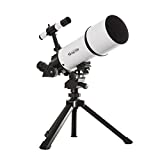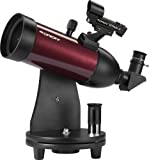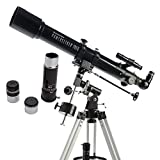Telescopes under 150 – Buying guide & Comparison
Do you lack time to browse through all the options that the market has available for sale in order to find the best telescope under 150? You’ve come to the right place, this short paragraph should help you get the model you need. After considering all the options, we believe the TwinStar AstroMark Telescope is the best because it provides great viewing and optics at a price that is hard to beat. The 80mm aperture and 400mm focal length will allow you to explore and view the entire solar system in more details than you would expect from affordable options such as this one. To make things better, the build of the product is also quite portable so that if you travel a lot, or just want to change the place you’re taking a peek at, with this alternate you can. If the TwinStar AstroMark Telescope is unavailable, we recommend the Orion GoScope 10013.
Comparison table
 Our Top Choice
Our Top Choice
The short optical tube makes it a portable option that people who travel a lot will certainly find ideal. The quality of the optics provided is excellent for the price, and you will notice that overall, this unit is a good value for the cost. You can use it for a variety of purposes, including hunting, so it’s a pretty good investment. Details of the moon and its craters can be easily observed.
The focuser components are made from plastic, so a bit flimsy.
An excellent pick for a traveling astronomer, due to its compact size.
 2nd Best
2nd Best
This model comes with an 80mm aperture, which is enough to provide you with good clear images of the moon, and nearby planets. Due to its tabletop design, it is easy to place anywhere you want. Also, if you so choose, you can mount it on a tripod and take it with you in the backyard. The maximum magnification is 35x, so it is a good tool for a beginner.
Figuring out the finder seems to be a challenge, as some buyers indicate.
A great option for a beginner, very easy to use.
Also To Consider
If you plan to explore the planets in our solar system, you will be more than pleased with what this model offers. Its 70mm aperture and 700mm focal length make it ideal for the purpose you have in mind, and you will get quite accurate details of the cosmic bodies involved. You will get a tripod, too, with your purchase, which means that you can start using it right away.
The tripod, while included, is a bit of a sore spot for some customers.
A telescope that provides superior performance.
Trying to find the best inexpensive telescope among the myriad of options out there can a seemingly never-ending task as the time that it can require out of you can end up making you feel discouraged. We believe that we can help simplify your decision-making process by giving you the information you need in the buying guide below. By taking into account the information we provide, it will be much easier for you to narrow down your searches to just one option.
The Aperture, a crucial component
If you’ve spent some time browsing through all the various options that the market has to offer, you’ve probably noticed one key feature that keeps getting mentioned, the aperture. The aperture of a telescope is the most important thing you have to consider when making a purchase because it can make the difference between a good and a bad product.
So what is the aperture? The aperture is the opening through which the light enters. It’s measured in millimeters or inches, and it measures the diameter of the lens or mirror inside the scope. Because in order to view things properly we need light, if you want to be able to see deep space objects well, you need a large aperture.
In the case of the aperture, size does matter, and bigger is always better. The larger the diameter, the more light will be able to reach your eye, and with more light, you will be able to view the details of the object you’re looking at better. When considering buying a good telescope for the money, you should consider the aperture as the deciding factor.
The focal length
The aperture is the most important part of your telescope, but the focal length comes in a close second. Just as with the aperture, a bigger focal length is always better and recommended. The larger it is, the better will it lend itself to high-magnification viewing without making the image get fuzzy.
While the aperture is the most important factor when it comes to deciding on the product you want to buy, the focus can make it easier for you to choose between two or more devices. If they all have the same aperture, the one with the larger focus could be the ideal choice for you.
Of course, you have to keep in mind that the size of the focal length will inevitably influence the size of the device. The bigger the focal length, the larger and longer your product will be. If size is a major factor for you and you want a more portable device, pay attention to this detail.
Magnification
The magnification of your telescope is a crucial aspect, but without proper lenses, you can have the most advanced eyepiece money can buy and it wouldn’t make much of a difference. The aperture and the focal length have an important part in deciding what magnification is best for your device.
The rule of thumb is that you can get anywhere between 20x to 50x of useful magnification per inch of aperture. This makes it easier for you to get the full benefit out of even the most affordable products on the market when considering that a magnification of 50x is enough to view Jupiter and its moons.
It is important to note that the magnification is given by the eyepiece which can be easily replaced. If you are not pleased with the magnification of the eyepiece that your product comes equipped with, it will be easy for you to swap it with another, if your lenses permit.
5 Best Telescopes under $150 (Reviews) in 2024
To help you decide, we have showcased some of the best cheap telescopes on the market below. We’ve looked at popular cheap telescope reviews to see what other consumer thought of the products so that we can come up with a selection of the top recommended options available. Have a look and see if we can help you.
Contents
1. White TwinStar AstroMark Power Portable Refractor Telescope

The product is a perfect choice for amateur astronomers and people that travel a lot. It is a portable device that allows you to easily use it for cityscape or landmark gazing, bird watching and even hunting. Due to its small size, it is also easy to store, which means that you can have it always in your car, ready to use at a moment’s notice.
The 80mm aperture and 400mm focal length will make sure that you miss no details, especially when observing the night sky. The Moon will show itself in a new light due to the help of the quality lenses and the large aperture which will make observing even the smallest of details possible.
Pros
This model is versatile and affordable, featuring a 16x minimum magnification and a 40x maximum one. It is a great choice for obtaining good images.
The telescope is more suitable for amateurs and people who travel a lot, or for people who are beginners in this field.
Since it is portable, you can use it for landmark gazing or cityscapes, and even birdwatching and hunting.
It is very easy to store this item, due to its small size. It is small enough to always have it in your car and ready to use at a moment’s notice.
You will not miss any details thanks to the 80mm aperture and the 400mm focal length, especially when exploring the night sky.
Cons
The focuser components may seem flimsy because they are made from plastic.
The small tripod requires a table or any other stable surface to focus.
Buy from Amazon.com
2. Orion 10013 GoScope TableTop Refractor Telescope

The Orion GoScope 10013 comes with a tabletop base which makes it extremely convenient to use. It is also exceptionally easy to mount, providing stability in an ultra-compact build.
If you prefer the added firmness and security of a tripod, you can easily mount the device on a tripod with a 3/8 inch or 1/4-20 threaded post.
While true that this is ideal for amateur astronomers, the size and mobility of the device make for a tempting option for even more experienced hobbyists. The 35x magnification makes it an ideal tool for observing the Moon and its details as well as planets such as Saturn and Jupiter.
Pros
The 80mm aperture refractor optics of this telescope allow you to observe the cosmic bodies within the solar system. It provides a lot of performance in a compact build.
With a magnification of 35x, you can easily observe the Moon, Jupiter, and Saturn with all their details.
To make it even more convenient, the unit comes with a tabletop design which offers stability and it is very easy to mount as well.
You can also use a tripod with a 3/8 inch or 1/4-20 threaded post if this is what you prefer.
Although this unit is perfect for beginners and amateur astronomers, the size and the portability makes it a very tempting option for more experienced users.
Cons
There were a few buyers who consider that figuring out how the finder works is a bit of a challenge.
Other customers would have liked to have a designated place to store the eyepieces.
Buy from Amazon.com
3. Celestron 21037 PowerSeeker 70EQ Refractor Telescope

Don’t let yourself get scared by the complexity of the product. The Celestron option may seem like a laborious thing to assemble but thankfully that is not the case. It requires no tools, and the product itself comes in two pieces: the tripod and the telescope. Assemble them, insert the desired eyepiece, and you’re set to go.
To make exploring the universe more fun and easier, Celestron also provides you with the SkyPortal app for free. With this app, you just have to point the phone at the sky and identify thousands of object with the help of a single tap.
Pros
Although this unit was built with premium materials and optics, it still comes with an affordable price.
The 70mm aperture and 700mm focal length will allow you to observe the planets and celestial objects from our solar system.
The telescope might seem complex and difficult to set up, but it requires no tools. As the pack comes with two pieces, the telescope, and the tripod, all you have to do is assemble them.
With this product, you also get the SkyPortal application for free. With its help, you simply point the phone toward the sky and it will identify thousands of objects with a single tap.
This telescope provides superior performance, and will not mess with your budget.
Cons
Not all customers are happy with how the tripod is built, as with the lightest touch, the telescope shakes.
Some buyers also had a hard time until they figured things out, as the instructions are not very detailed.
Buy from Amazon.com
4. Orion SpaceProbe II Altazimuth Reflector Telescope Kit

The 76mm aperture is large enough to allow you to view the Moon in ways you have never seen it before. You will even be able to see distant planets such as Jupiter and Saturn, as well as some nebulas.
The stable altazimuth mount and tripod will provide the product with smooth motion in both up/down and left/right axes. This means that this device will make it easier than ever for you to observe the entirety of the night sky, leaving no spot unexplored.
The Orion SpaceProbe 11043 also comes equipped with an EZ Finder II reflex sight which makes finding celestial object an effortless task. You just have to place the red dot on the object after you’ve aligned the telescope and you’re ready to observe.
Pros
You can buy this telescope for your children, or for yourself, as it has all the features you require for an affordable price.
You will be able to see the Moon and even distant planets like Saturn or Jupiter, and also some nebulas. This is possible due to the 76mm aperture.
Thanks to the altazimuth mount and tripod, the telescope is provided with smooth motion in both right/left and up/down axes. You can observe the sky without leaving any spots unexplored.
Finding a celestial body is a piece of cake, as the telescope is equipped with the EZ Finder II reflex sight. Simply align the telescope and place the red dot on the object.
Cons
There are buyers who consider that the tripod seems loose at its hinges, although there are no issues once the legs are extended and planted on the ground.
Buy from Amazon.com
5. Orion 10012 SkyScanner TableTop Reflector Telescope

At just 6.2 pounds, the Orion alternative will please customers that want their product to be compact and easy to carry and storage. If you want to escape the lights of the city and have a better view of the night sky, with this product you can without having to worry about its weight.
The included eyepieces of 20mm and 10mm offer a magnification of 20x and 40x respectively. This should be enough to satisfy amateur astronomers, but if you want a little more power, you can buy additional eyepieces to boost your viewing experience.
Pros
Pay less and get the most out of your telescope with this model. It comes with an aperture of 100mm and a focal length of 400mm.
Thanks to the high quality of the glass lenses, you can get very detailed images of the Moon, and other planets such as Jupiter, but also mesmerizing views of the Milky Way.
Since it weighs only 6.2 pounds, this telescope is perfect for people who need a unit that is easy to store and carry.
When you buy this product you get eyepieces of 20mm and 10mm which offer magnifications of 20x and 40x.
This unit is equipped with everything an amateur astronomer could be looking for.
Cons
The position this telescope requires is not the most comfortable one according to some buyers.
Also, the instructions could be a little more detailed as other customers mentioned.
Buy from Amazon.com











